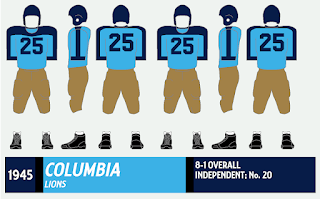In our last post, I promised another bizarre uniform from the late 1920s-early '30s in addition to Vermont's funky garb. Well, I lied: I'll give you two.
While searching through some old Middlebury Kaleidoscope yearbooks for Vermont action photos (Middlebury and UVM were annual rivals in those days), I came across this photo featuring the Panthers and the school that came to be known as UMass:
This might be the most bizarre old-time action photo I've encountered in this project, which is why doing uniform research so much fun and addictive.
Let's start with the UMass Minutemen -- or the Massachusetts Agricultural College Aggies, as they were known then in the parlance of the time for agricultural schools, or "cow colleges," as they were derisively called. These guys resemble a prison team on the break, anticipating the early Pittsburgh Steelers (nee Pirates) uniforms a few years later. If that wasn't enough, the Aggies (God, that's weird to type) were given matching striped socks, although a couple players wore more conventional hose.
Another oddity to this odd uniform, which was worn only one season: It appears the players wore no numbers on the back, which is kinda ironic for a prison-themed uniform, no? Take a good gander at the blown-up pic below from the 1932 UMass Index yearbook (which covered the 1930-31 school year):
Only stripes cross the back. That might be a relief for embarrassed players who couldn't be identified even with a scorecard.
Shortly after the season, the school changed its name to Massachusetts State College (a named that lasted only until after World War II), and with it came a new name (the Statesmen) and new uniforms (plain maroon jerseys with numbers on front and back). The Aggies -- and their prison garb -- were never to be spoken of again, except perhaps by Depression-era uni-watchers.
The black helmets on the graphic, BTW, are just a guess on my part. Since UMass wore black helmets in the late 1930s and these lids appear to be a darker hue than the jerseys, I opted to stick with black.
On to Middlebury, which wore some flashy gear of its own in 1930: Big white stripes over a blue jersey. Also note the helmet, which has a white stripe across the sides and the back, but not the front.
But a little digging shows that might not even be the most oddball uni in Middlebury's arsenal. In 1929, the Panthers used different stripes -- thinner and slightly curved -- on the jerseys. Maybe they were trying to look unique, or perhaps they were getting a jump on Halloween. Hey, football is played in the autumn ...
Another oddity to this odd uniform, which was worn only one season: It appears the players wore no numbers on the back, which is kinda ironic for a prison-themed uniform, no? Take a good gander at the blown-up pic below from the 1932 UMass Index yearbook (which covered the 1930-31 school year):
Shortly after the season, the school changed its name to Massachusetts State College (a named that lasted only until after World War II), and with it came a new name (the Statesmen) and new uniforms (plain maroon jerseys with numbers on front and back). The Aggies -- and their prison garb -- were never to be spoken of again, except perhaps by Depression-era uni-watchers.
The black helmets on the graphic, BTW, are just a guess on my part. Since UMass wore black helmets in the late 1930s and these lids appear to be a darker hue than the jerseys, I opted to stick with black.
On to Middlebury, which wore some flashy gear of its own in 1930: Big white stripes over a blue jersey. Also note the helmet, which has a white stripe across the sides and the back, but not the front.
But a little digging shows that might not even be the most oddball uni in Middlebury's arsenal. In 1929, the Panthers used different stripes -- thinner and slightly curved -- on the jerseys. Maybe they were trying to look unique, or perhaps they were getting a jump on Halloween. Hey, football is played in the autumn ...
 |
| The inspiration for Middlebury's 1929 uniform? |
For at least one game in 1929 (against Williams), Middlebury wore white short-sleeved shirts over the "conventional" jerseys, presumably to prevent confusion on the field since both team were wearing dark uniforms. And it appears these jerseys didn't have numbers, either:
The "skeleton" jerseys were worn from 1928-29, while the, er, less unconventional shirts were worn until the mid-1930s.
On another note, it's hard to believe Middlebury and UMass were once on similar athletic ground. One school wound up in Division III and the other is now playing D-I FBS football. Such was the case in the early years of intercollegiate sports, when teams were just looking for a game against anybody as long as it didn't require a lengthy road trip.
 |
| The Middlebury "skeleton" uniforms in action against Vermont, 1929. |
Much, much more from UMass: 2016, 2015, 2014, 2013, 2000-02, 1986-87, 1978-84, 1975-77, 1974, 1973, 1972, 1966-68, 1960-62, 1953-54, 1951-52, 1938-39. Tribute: Dick McPherson.
And one other uni from Middlebury: 1978.
































